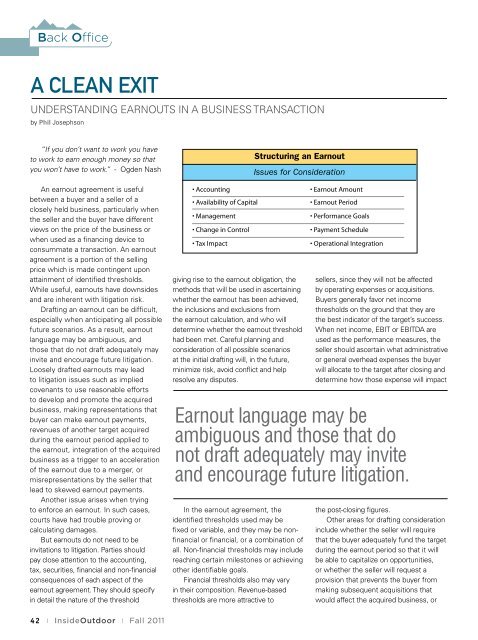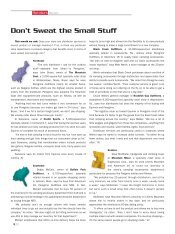Fall - InsideOutdoor Magazine
Fall - InsideOutdoor Magazine
Fall - InsideOutdoor Magazine
Create successful ePaper yourself
Turn your PDF publications into a flip-book with our unique Google optimized e-Paper software.
Back Office<br />
A Clean Exit<br />
Understanding earnouts in a business transaction<br />
by Phil Josephson<br />
“If you don’t want to work you have<br />
to work to earn enough money so that<br />
you won’t have to work.” - Ogden Nash<br />
An earnout agreement is useful<br />
between a buyer and a seller of a<br />
closely held business, particularly when<br />
the seller and the buyer have different<br />
views on the price of the business or<br />
when used as a financing device to<br />
consummate a transaction. An earnout<br />
agreement is a portion of the selling<br />
price which is made contingent upon<br />
attainment of identified thresholds.<br />
While useful, earnouts have downsides<br />
and are inherent with litigation risk.<br />
Drafting an earnout can be difficult,<br />
especially when anticipating all possible<br />
future scenarios. As a result, earnout<br />
language may be ambiguous, and<br />
those that do not draft adequately may<br />
invite and encourage future litigation.<br />
Loosely drafted earnouts may lead<br />
to litigation issues such as implied<br />
covenants to use reasonable efforts<br />
to develop and promote the acquired<br />
business, making representations that<br />
buyer can make earnout payments,<br />
revenues of another target acquired<br />
during the earnout period applied to<br />
the earnout, integration of the acquired<br />
business as a trigger to an acceleration<br />
of the earnout due to a merger, or<br />
misrepresentations by the seller that<br />
lead to skewed earnout payments.<br />
Another issue arises when trying<br />
to enforce an earnout. In such cases,<br />
courts have had trouble proving or<br />
calculating damages.<br />
But earnouts do not need to be<br />
invitations to litigation. Parties should<br />
pay close attention to the accounting,<br />
tax, securities, financial and non-financial<br />
consequences of each aspect of the<br />
earnout agreement. They should specify<br />
in detail the nature of the threshold<br />
42 | <strong>InsideOutdoor</strong> | <strong>Fall</strong> 2011<br />
• Accounting<br />
• Availability of Capital<br />
• Management<br />
• Change in Control<br />
• Tax Impact<br />
Structuring an Earnout<br />
Issues for Consideration<br />
• Earnout Amount<br />
• Earnout Period<br />
• Performance Goals<br />
• Payment Schedule<br />
• Operational Integration<br />
giving rise to the earnout obligation, the sellers, since they will not be affected<br />
methods that will be used in ascertaining by operating expenses or acquisitions.<br />
whether Would the earnout your buying has been patterns achieved, change Buyers generally favor net income<br />
the for inclusions large and brands exclusions that from you already thresholds stock on the ground that they are<br />
the if earnout they calculation, decided and to who start will selling the direct best indicator of the target’s success.<br />
determine to customers whether the on earnout their threshold Web siteWhen net income, EBIT or EBITDA are<br />
had been met. Careful planning and used as the performance measures, the<br />
Yes, I would stop buying<br />
consideration of all from possible that Brand scenarios<br />
11%<br />
seller should ascertain what administrative<br />
at the Yes, initial I would drafting buy as little will, as in possible the future, or general overhead expenses the buyer<br />
from the brand<br />
19%<br />
minimize risk, avoid conflict and help will allocate to the target after closing and<br />
Yes, I would reduce my buying<br />
resolve any disputes. from that brand<br />
determine 34% how those expense will impact<br />
No, I would not change my buying<br />
from that brand<br />
13%<br />
Earnout language may be<br />
I am not sure<br />
23%<br />
Source: Shopatron<br />
ambiguous and those that do<br />
not draft adequately may invite<br />
and encourage future litigation.<br />
Outdoor Participation, 2006 to 2010<br />
In the earnout agreement, the the post-closing figures.<br />
identified thresholds used may be<br />
Other areas for drafting consideration<br />
Total Outdoor Outings<br />
fixed or variable, and they may be nonfinancial<br />
11.6 Billion or financial, 11.4 Billion or a 11.2<br />
include whether the seller will require<br />
combination Billion<br />
of that the buyer adequately fund the target<br />
all. Non-financial thresholds may include 10.1 Billion 10.1 Billion<br />
during the earnout period so that it will<br />
reaching certain Number milestones of Participants or achieving be able to capitalize on opportunities,<br />
other identifiable 138.4 Billion goals.<br />
or whether the seller will request a<br />
137.8 Billion 137.9 Billion<br />
Financial thresholds 135.9 also Billion<br />
134.4 Billion<br />
may vary provision that prevents the buyer from<br />
in their composition. Revenue-based making subsequent acquisitions that<br />
Participation Rate<br />
thresholds are more attractive to<br />
would affect the acquired business, or<br />
49.1% 50.0% 48.6% 48.9% 48.6%

















